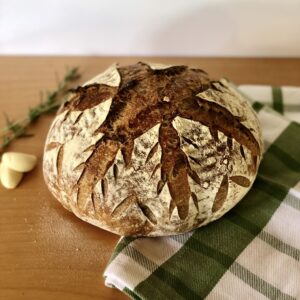0 Comments
share this
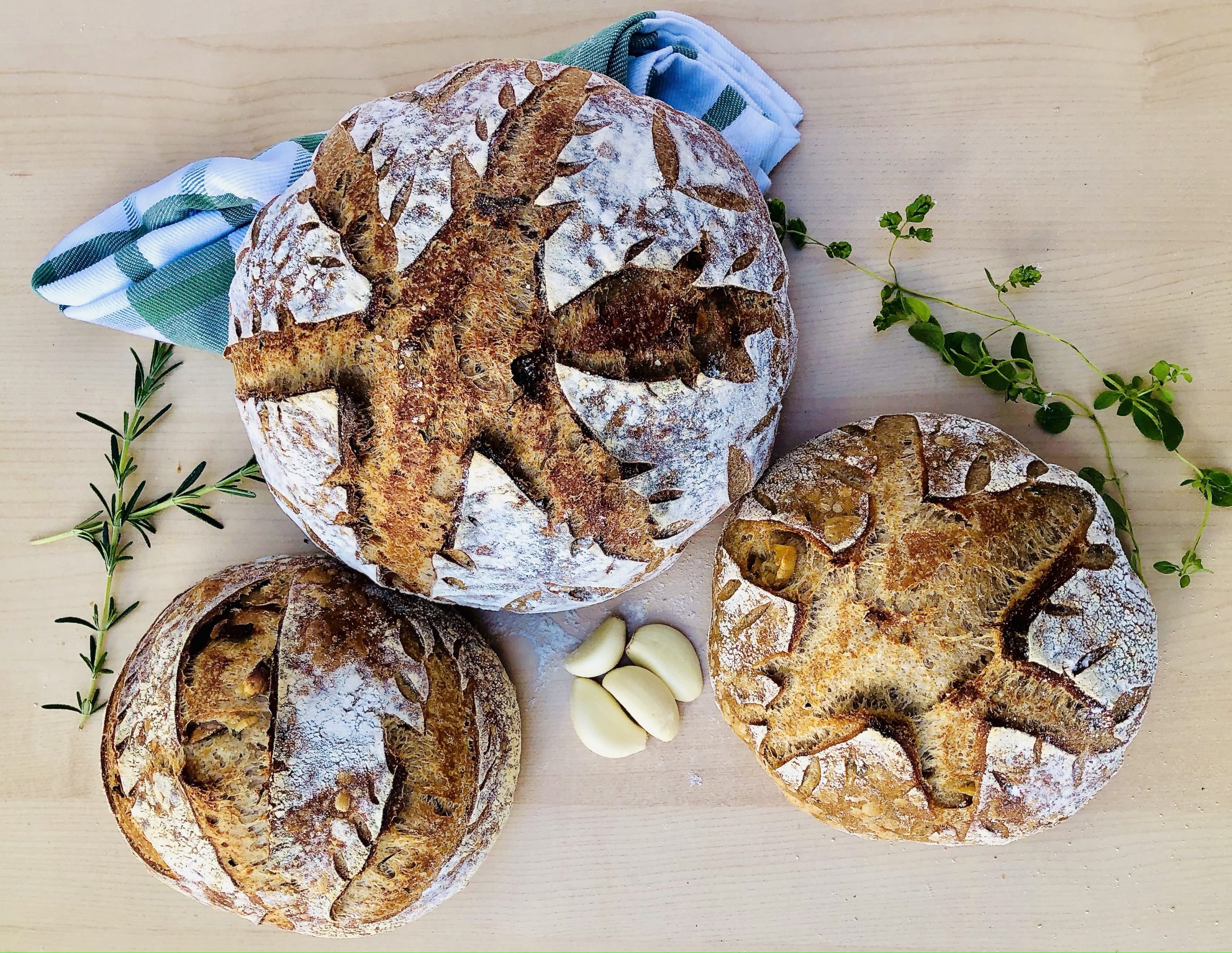
This roasted garlic and fresh herb sourdough is great with both sweet and savory accompaniments. The garlic, once roasted, turns into a sweet spread of deliciousness which is complemented with the rosemary, oregano and thyme. Garlic not only tastes and smells great when roasting, but has many health benefits as well.
The savory accompaniments came from our first CSA box from Yasukochi Family Farms. CSA (Communiity Supported Agriculture) is another silver lining that has come out of this Pandemic. By supporting these local growers, we are not only getting delicious and very fresh produce but also the variety expands our culinary tastes. I'm excited to be developing recipes with the continuously changing produce that I'll feature on the blog. This savory bread is topped with caramelized red onion and bruschetta. I made the bruschetta the day after the box was delivered and the basil had wilted. I tried to revive the leaves by cutting off some stem and placing it in water. This did not do too much for the basil. However, I had some tips of a basil left over and I cut the stem close to the leaves and this is what it looks like 4 days later!
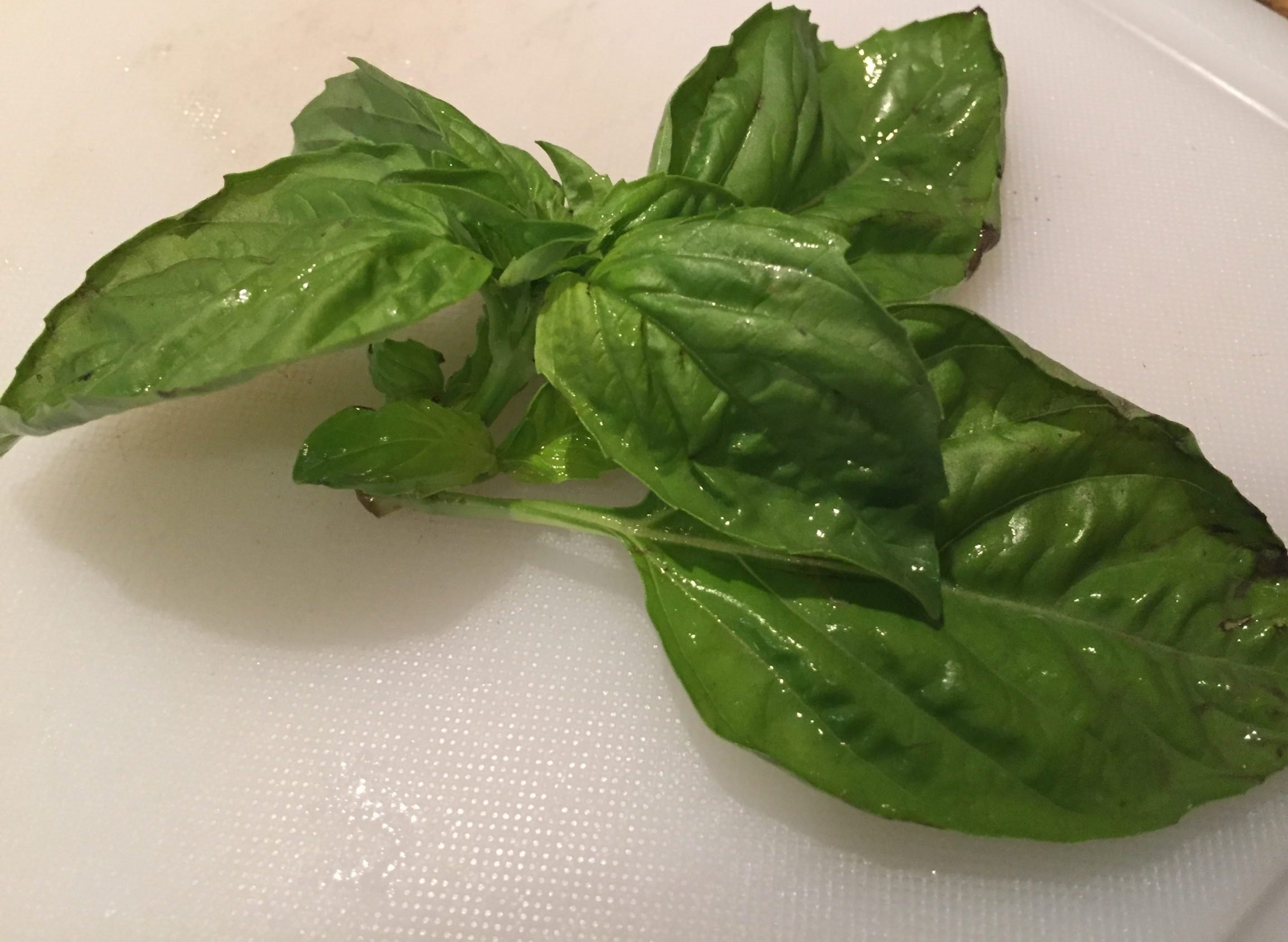
Fresh basil. Revive basil by cutting the stem close to the leaves and placing it in water.
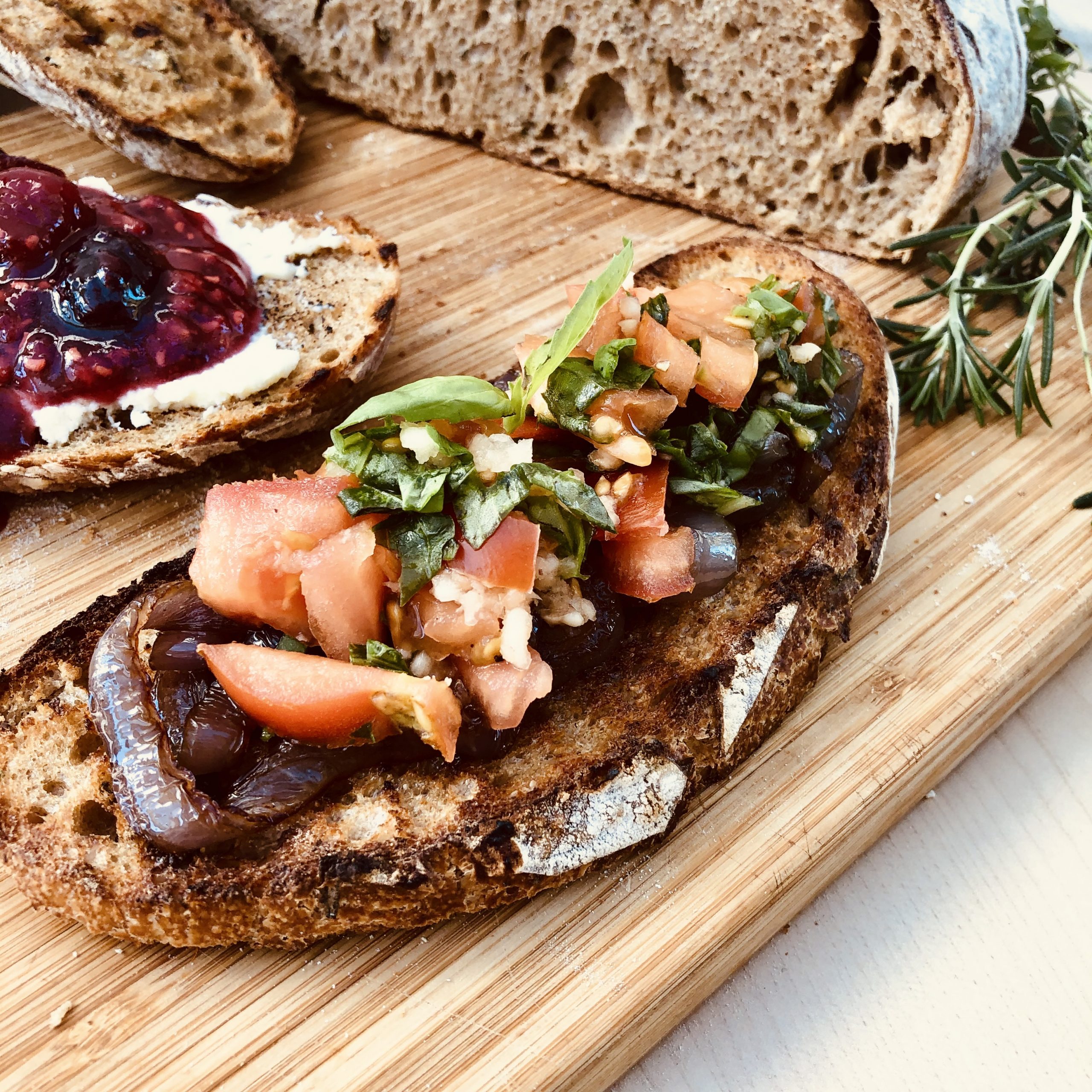
Savory bruschetta on roasted garlic and herbs sourdough.
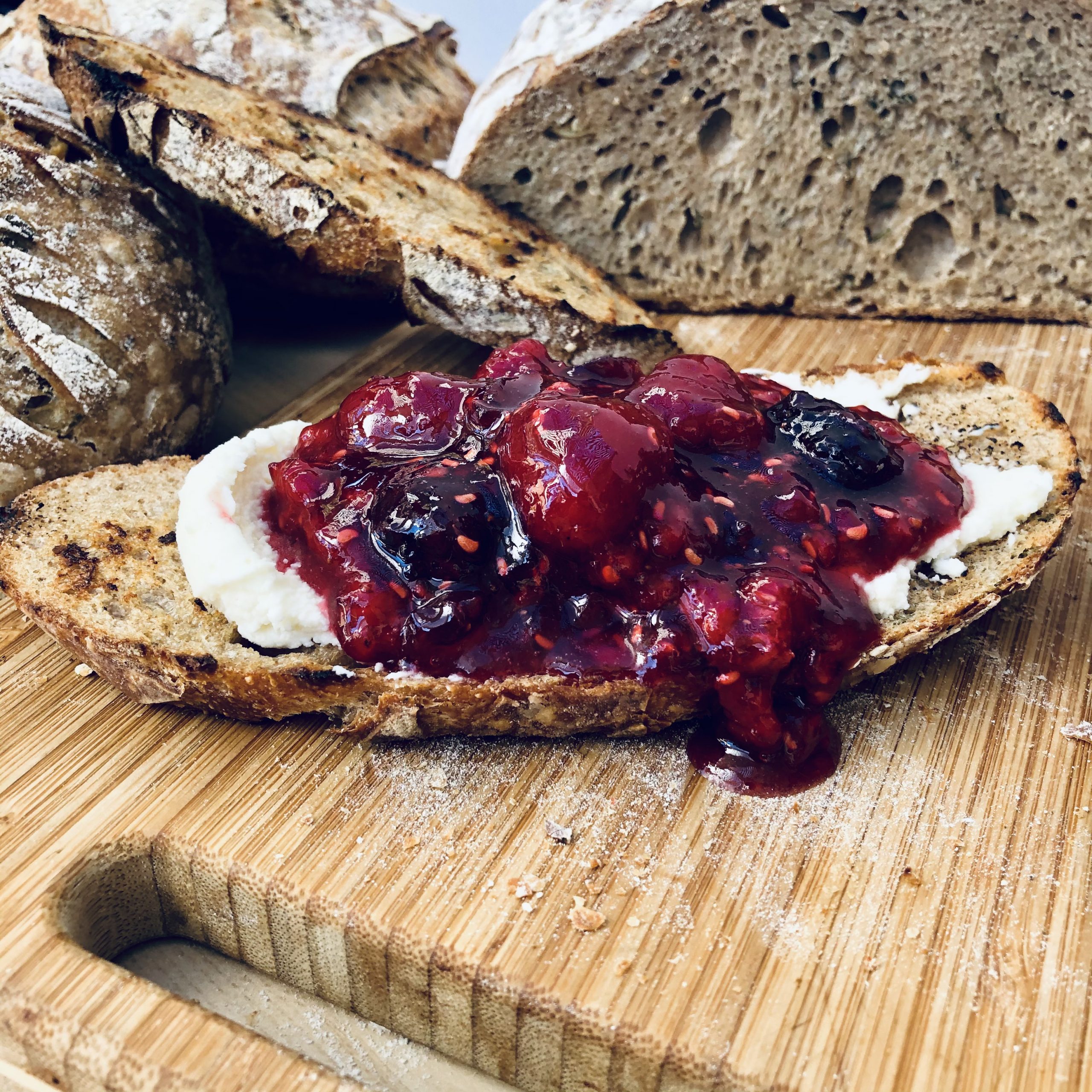
Mascapone cheese with berry preserves on roasted garlic and herbs sourdough.
The recipe has a quick rise and a slow rise version. The quick rise recipe allows you to make and bake your bread the same day. However, allowing the sourdough to proof in the refrigerator overnight maximizes the nutrition of sourdough bread.
This roasted garlic and fresh herb sourdough, I use a combination of both whole wheat flour and bread flour. The whole wheat flour has more fiber and is less refined. This results in a slightly more dense bread which keeps you feeling full for a longer period. If you do not like the look of a darker bread, you can substitute it with a whole wheat white bread.
Tips.
Inclusions.
For this roasted garlic and fresh herb sourdough, it is best to add the fresh herbs during the third stretch and fold. Adding it at this time allows the dough to strengthen during the first two stretch and folds, but gives the herbs enough stretch and folds to disperse itself throughout the dough.
The garlic can be added during shaping to allow all the garlic to be enclosed in the dough. This will reduce the possibility of the garlic from coming too close to the surface of the bread and burning during baking.
ROASTED GARLIC AND FRESH HERB SOURDOUGH
Equipment
- Cast Iron dutch oven
- 2 Large Bowls
- Bread lame, razor or pair of scissors
- Dish towel to cover dough
Ingredients
- 370 grams water (80 degrees-lukewarm)
- 20 grams water boiling water needed for salt solution
- 350 grams bread flour
- 150 grams whole wheat flour
- 9 grams salt
- rice / bread flour mixture Used for dusting your proofing bowl / banneton
- 100 grams levain or very active starter See "What is levain and how to make it"
Inclusions
- 10 cloves fresh garlic depending on taste.
- 1 Tbsp fresh chopped rosemary depending on taste
- 1 Tbsp fresh chopped oregano depending on taste
- 1 Tbsp fresh chopped thyme
- 1 tsp olive oil
Instructions
Make your Levain
- Make your levain the night before or use VERY ACTIVE starter.
Prepare Inclusions
- Remove outer layer of half a bulb of garlic or 10 cloves of garlic
- Drizzle with olive oil.
- Wrap in foil and bake in a toaster oven at 350° fahrenheit or 177° celcius for 20 minutes.
- Slice width-wise or coarsely chop.
- Chop fresh rosemary
- Chop fresh oregano
- Chop fresh thyme
Making your bread dough
- Sift you bread and wheat flour into a bowl. I do this because some bread flours are very refined and clumpy. Sifting helps remove those clumps.
- In another bowl, add your levain to your lukewarm water and stir to mix. It does not have to dissolve.
- Mix in your flour mix and let sit for 1 hour. This allows your dough to autolyze, allowing the flour to completely absorb all the liquid making it easier to work with and allow the sourdough to break down the micro-organisms in the whole wheat flour.
- Dissolve 20 grams of boiling water with the salt and let it cool during the autolyzing process.
Kneading the bread dough.
- The dough is now ready for bulk fermentation where it will develop its flavor and body! Ambient temperatures between 70-80 degrees Fahrenheit will take 3 hours for bulk fermentation
- Add the salt solution after the dough has autolyzed.
- I stretch and fold the dough by hand...very therapeutic. Using wet hands, I pull and stretch the dough out at the top and fold it back on itself, I then rotate the dough a quarter turn and do the same thing 16 times. (4 complete revolutions!)
- Let dough rest for 30 minutes. You will notice that the dough will become more pliable with time. Cover and let sit for 30 minutes. Don’t forget to set your timer! Set timer for 30 minutes
- Knead dough
- Let it rest for 30 minutes.Set timer for 30 minutes
- Knead dough
- Let dough rest for 30 minutesSet timer for 30 minutes
- Add the chopped rosemary.
- Knead dough
- Let dough rest for 30 minutesSet timer for 30 minutes
- Knead dough
- Let dough rest for 30 minutesSet timer for 30 minutes
- Knead dough
- Let dough rest for 30 minutesSet timer for 30 minutes
- Knead dough. The dough should be soft and pliable. If not, continue bulk fermentation for another 30 mins - 1 hour.
Shaping your bread dough.
- Pull dough out of the container with top side of the dough on the floured surface.
- Gently pull the outer edges of the dough, making a flat, rectangular "pizza"
- Sprinkle the chopped roasted garlic .
- Roll the dough from the short side edge and tuck the the 2 sides (with the swirls) underneath, forming a squarish ball.
- On a floured surface, work it into a ball by pulling it towards you and rotating. It should become somewhat taut as you pull the dough, part of your goal is to remove most of the air bubbles that were created during the fermentation process. I have found that if you keep these air bubbles, your bread will be very porous with a lot of air bubbles (almost like a ciabatta). Some people like this, other people want a little more substance. See Cutting and Shaping your Dough in my Tips & Tricks section.
- Let it sit for 20 minutes. Set timer for 20 minutes
- Shape again. See Cutting and Shaping your Dough in my Tips & Tricks section.
- Prepare your banneton (Coiled rattan baskets for proofing) by generously dusting the bowl or banneton with your bread and rice flour mixture. Dust the tops of your loaves with flour and place it in a bowl or banneton with the dome side on the bottom of the banneton.
Proofing your dough - Quick Proof
- Cover your banneton with a damp cloth and let rise in a warm place for 2 hours. I usually put this in my oven with the oven light on.Proof dough for 120 minutes
- Take your dough out and preheat oven to 500° fahrenheit (260° Celcius) with your cast iron dutch oven in it. (Should take about an hour depending to get your cast iron pot to the desired temperature.) This will be a total of 3 hours of proofing. I have proofed bread for 4 hours. However, overproofing your dough with cause your dough to lose its ability to have enough strength for the "oven-spring" (the last rise in the oven as a result of intense heat).
Proofing your dough - Slow Proof for maximum nutrition.
- Allow dough to proof at room temperature for one hour before cold proofing.
- Place your banneton in a plastic bag. Seal it with a clip. Place it in the refrigerator for 12-16 hours.
- Preheat oven to 500° fahrenheit (260° Celcius) with your cast iron dutch oven in it. (Should take about an hour depending to get your cast iron pot to the desired temperature.
Scoring your dough.
- The dough should be fairly firm but not impossible to handle after proofing. Take a piece of parchment paper that will generously cover the top of the bowl/banneton. Crumple it so that it folds easily in the pot. Place it over the bowl/banneton.
- Flip the banneton over. The dough is now ready for scoring
- Dust the top of the dough with a little more flour if necessary or brush off excess flour from proofing. Score the bread by cutting it with a razor blade, bread lame, or a pair of scissors. Scoring the bread allows for oven spring when the dough expands quickly during baking and gives your dough a pretty design. See Scoring your dough in my Tips & Tricks section.
- Gently lower your scored bread into the dutch oven. If you have a cast iron skillet / dutch oven set as shown on my "Helpful Tools" section. After scoring, place the dough in the skillet of the set and cover the dough with the dutch-oven section. Place it in the oven with the skillet on the bottom.
- Cover.
Baking your bread
- Reduce oven temperature to 450°F
- Bake for 25 minutes. Smaller 2 quart bolles should bake for 20 minutes.Set timer for 25 minutes for large bolle Set timer for 20 minutes for small bolle
- Remove the lid and continue baking for an additional 25 or 20 minutes respectively.Set timer for 25 minutes for large bolle Set timer for 20 minutes for small bolle
- Remove from oven and remove from dutch oven and let cool on wire rack.
- To bake the second loaf, after removing the first loaf, bring the oven temperature back to 500 degrees, wipe the dutch oven with a clean dry towel, place the dutch oven in it for 10 minutes and bake according to recipe.
- Bread should cool for at least an hour before attempting to slice into it!
Notes
Nutrition
Need meal ideas?
EASY, HEALTHY, DELICIOUS!
DON'T MISS A RECIPE

